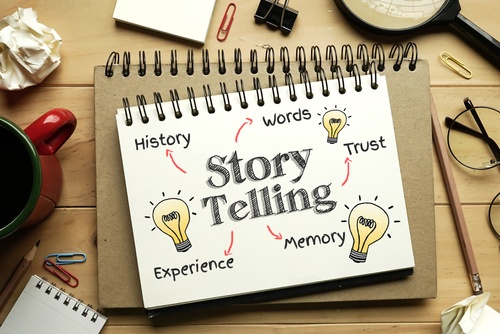Today, online marketing has created a super informed buyer that may need to know more than just features and price to buy from you. Consumers are savvy and aren’t interested in being “sold.” They seek information and are looking for solutions. Old school sales pitches tend to focus on the seller – their company, capabilities and the accolades they’ve received. If you want to increase your sales, ditch the pitch and tell prospects your story.
Why Stories Work
 The power of stories lies in the listener’s empathy. They help us relate to the characters who face similar problems and how they overcame them. Storytelling humanizes the sales process by creating a bond between the storyteller and the listener.
The power of stories lies in the listener’s empathy. They help us relate to the characters who face similar problems and how they overcame them. Storytelling humanizes the sales process by creating a bond between the storyteller and the listener.
Storytelling is backed by research. Recent studies have shown that on 5% of meeting attendees remember statistics, while 63% recall stories. If you build a story and share a connection, you’re more likely to create a lasting bond.
Telling Effective Stories
If you’re sold on storytelling you’re on the right track. It has major benefits over the traditional sales pitch. It is, however, an art form that will take some time and practice to master. Here are three tips to help you get started.
- Focus on Them. If you place your company before their needs, your prospect is probably tuning out. Understand their needs, address their pain points and offer viable solutions without the sales pitch.
- Cover Their Pain Points in Your Story. Instead of focusing on your capabilities speak to their needs and provide solutions. Listen more than you speak and you’ll learn about them.
- Build a Consistent and Varied Repertoire. A story bank full of past successes is only effective if it’s consistent. Make sure your team is on point and telling the same stories to improve the effectiveness of this technique.
Popular Story Ideas
The Positive Reference Story – May start with “Let me tell you a story about another client we have that was in your situation and how they leveraged our solution”. These stories are essentially a mini case study gift wrapped in a story that hits on the challenge, the solution you provided and the results they achieved by selecting you. People can relate to other people’s experiences and will gravitate towards your product if they feel confident others have done the same.
The Negative Reference Story – This story follows the same structure as the positive story but speaks to a missed opportunity or the problems another “like” organization experienced by not selecting your solution. Often these stories end with some form of financial loss, employee dissatisfaction, lost productivity, or a negative impact to customer retention.
When used effectively, storytelling is a great way to connect with your prospects on a deeper level than the traditional sales pitch, but it takes practice. The best salespeople have rehearsed stories to make sure they are relevant and short enough to keep the prospect’s attention.
Getting Started
Sales Coach, Rick Lambert, of selltowin.com suggests you write down three common prospect profiles. Each with common pain points and a possible reluctance to moving ahead with your solution. Then he suggests you align a customer success story with each prospect profile using the case study template of challenges, solution(s) provided, and business outcomes achieved. Keeping your stories to less than two minutes can also help customers follow your story better and retain key information.
Like most things, practice makes perfect and the better your stories, the better your chances will be to sway more customers in a way that helps you close more deals.
Do you have any further questions? Please, feel to contact us!



